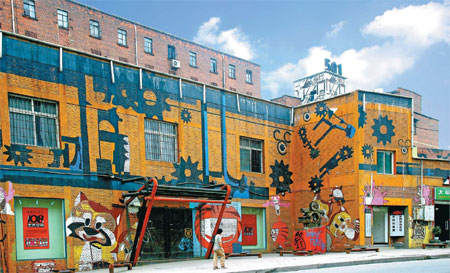Gritty reality paints promising portrait
Updated: 2012-09-07 08:06
By Richard Macauley (China Daily)
|
|||||||||
|
Buildings on Huangjueping's 'Graffiti Street' in southwest China's Chongqing. Jing Aiping / for China Daily |

Although not as famous as Beijing's 798, the art district in the sprawling southwestern megatropolis of Chongqing is home to a growing, innovative and international community. Report by Richard Macauley in Chongqing
'Everything here is so authentic," says Bartek Wegrzyn. The Polish artist is looking out through the cafe window as he speaks, assessing the small side street on the other side of the glass. Inside, there is Wi-Fi, and coffee and cocktails are on the menu. Artists, lecturers and art students sit in groups, exchanging ideas and peering at computers and tablets, most of which sport a glowing Apple logo.
The other side of the window offers a different world: A carwash and repair shop is located across the narrow street, alongside tiny restaurants selling noodles, potato snacks and buns. Plastic stools have been set outdoors so customers can enjoy the pleasant weather and lack of traffic. As they do every day, a group of pensioners has gathered to sit outside and chat.
"The artist community is very young and entirely original here," says Wegrzyn. "It's exciting. And yet when you look outside, you still see thriving, traditional Chinese culture. It's a very stimulating environment."
The young artistic community that has made Chongqing its home shares space with a still-operational power plant, Sichuan street culture and - most immediately noticeable - two long and proud smoke stacks that tower over and dominate Huangjueping's main street. Indeed, everything about Huangjueping, an area just south of Chongqing's modern downtown area, is thoroughly real.
Sense of spontaneity
Unlike the neatly curated atmosphere of Beijing's 798 art district or others found in many international cities, Chongqing's art area maintains a sense of spontaneity, grit, and is still awash with residents who have lived in the town their entire lives.
They remember Chongqing's days as a rustic yet heavily industrial manufacturing town, and they continue traditional pastimes in dark, almost inaccessible tea houses; sweating over outdoor hotpot, despite searing summer temperatures, or cooling off with fans in the shade of the many trees that line Huangjueping's streets.
In 1940 the Sichuan Fine Arts Institute, one of China's eight greatest art colleges, opened its campus there, meaning art has been central to the town's identity for more than 70 years.
Recently though, most of the students were relocated to a new campus outside of Chongqing's main urban area, as the enormous city aims to centralize its university campuses.
"Will this affect the atmosphere of the place? No, I don't think so," says Yang Shu, founder of Organhaus, an art studio that has been operating in Huangjueping for six years and aims to push forward China's contemporary art scene. "The campus that attracted students here focused only on teaching art techniques."
Indeed, the institute has a reputation for conservatism in its approach to teaching. "The artists who move here to work (as opposed to study), are concerned with more contemporary art," adds Yang.
Dust and sand
International artists based in the area are very much involved with contemporary art and are passionate about remaining in Chongqing and supporting its fledgling art industry.
British painter Oliver Gosling has lived in the district since 2008. "The art scene here is not as big as Beijing's or Shanghai's, but even though there's not as much happening, there are always unexpected encounters," he says.
"In many cities you need to be outrageous to have your art noticed. You need to be a showman and a networker. Here though, people see your work and want to talk about it."
Gosling creates paintings that leave the viewer with a great deal of room for imagination. It would be inaccurate to describe his style as purely abstract, but the images he produces are designed to be interpreted at least somewhat differently by each person who experiences them.
"I like to propose something in my paintings," he says. "There are clues in every image I create, but how these are interpreted is up to each individual," he points to one painting of a single line of barbed wire in front of abandoned chairs strewn across a landscape of dust and sand. "I have my own concept of how these items - the chairs, the barbed wire - might have come to be in the desert they are shown in," he says.
"But if someone wants to discuss alternatives then that's great."

 Relief reaches isolated village
Relief reaches isolated village
 Rainfall poses new threats to quake-hit region
Rainfall poses new threats to quake-hit region
 Funerals begin for Boston bombing victims
Funerals begin for Boston bombing victims
 Quake takeaway from China's Air Force
Quake takeaway from China's Air Force
 Obama celebrates young inventors at science fair
Obama celebrates young inventors at science fair
 Earth Day marked around the world
Earth Day marked around the world
 Volunteer team helping students find sense of normalcy
Volunteer team helping students find sense of normalcy
 Ethnic groups quick to join rescue efforts
Ethnic groups quick to join rescue efforts
Most Viewed
Editor's Picks

|

|

|

|

|

|
Today's Top News
Health new priority for quake zone
Xi meets US top military officer
Japan's boats driven out of Diaoyu
China mulls online shopping legislation
Bird flu death toll rises to 22
Putin appoints new ambassador to China
Japanese ships blocked from Diaoyu Islands
Inspired by Guan, more Chinese pick up golf
US Weekly

|

|








